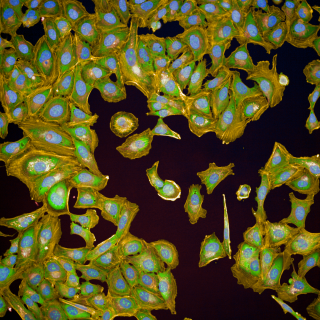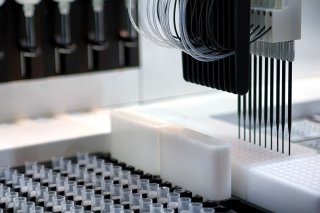High-Throughput Profiling Using Transcriptomics and High Content Imaging

EPA scientists have developed novel high-throughput methods to generate bioactivity information on thousands of chemicals and to help prioritize chemicals (low vs. high risk) for in-depth risk assessments.
As part of a revitalized strategy for chemical hazard evaluation1, scientists at EPA are using high-throughput transcriptomics (HTTr) and imaging-based high-throughput phenotypic profiling (HTPP) methods to characterize the biological activity of chemicals.
Transcriptomics is the study of gene expression patterns in cells, tissues or whole organisms. EPA scientists use HTTr profiling with targeted RNA-Seq to measure changes in gene expression in a cell after chemical exposures.

Likewise, HTPP uses the Cell Painting assay2, 3 to measure changes in the form or structure (i.e. morphology) of a cell in response to a stressor, such as a chemical. HTPP combines fluorescent cytochemistry and high-content imaging to allow scientists to identify different parts of the cell (e.g. nucleus, endoplasmic reticulum, golgi apparatus, mitochondria, cytoskeleton) and characterize the response to a chemical.
When conducted in concentration-response screening mode, HTTr and HTPP can be used to determine at what concentration each chemical impacts cellular biology at the molecular level. Profiles from HTTr and HTPP can also be used to characterize the mechanism(s) underlying a chemical’s biological activity, group chemicals with similar characteristics, and develop adverse outcome pathways (AOPs).
To learn more about high-throughput toxicology research and HTPP methods, watch this EPA lab video:
More Resources
- Safer Chemicals Research
- High-Throughput Toxicology Research
- Related Publications
- New Approach Methods Research
- Center Computational Toxicology and Exposure
Related Publications:
High-Throughput Transcriptomics (HTTr)
High-throughput toxicogenomic screening of chemicals in the environment using metabolically competent hepatic cell cultures. January 27, 2021.
High-Throughput Transcriptomics Platform for Screening Environmental Chemicals. April 27, 2021.
High-Throughput Transcriptomics of Water Extracts Detects Reductions in Biological Activity with Water Treatment Processes. January 2024.
High-Throughput Phenotypic Profiling (HTPP)
Application of Cell Painting for Chemical Hazard Evaluation In Support of Screening-Level Chemical Assessments. April 11, 2023.
Optimization of Human Neural Progenitor Cells for an Imaging-Based High-Throughput Phenotypic Profiling Assay for Developmental Neurotoxicity Screening. February, 2022.
Comparison of Approaches for Determining Bioactivity Hits from High-Dimensional Profiling Data. February 2021.
Bioactivity Screening of Environmental Chemicals Using Imaging-Based High-Throughput Phenotypic Profiling. January 2020.
Citations:
- The Next Generation Blueprint of Computational Toxicology at the U.S. Environmental Protection Agency (Thomas et al. 2021)
- Cell Painting, a high-content image-based assay for morphological profiling using multiplexed fluorescent dyes (Bray et al. 2016)
-
Application of Cell Painting for chemical hazard evaluation in support of screening-level chemical assessments (Nyffeler et al. 2023)
